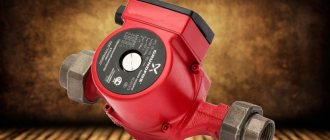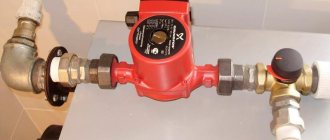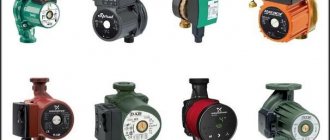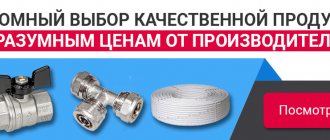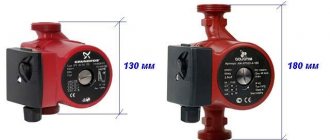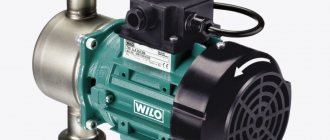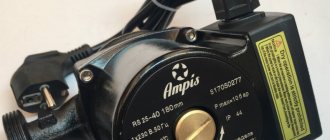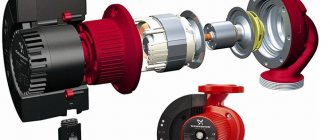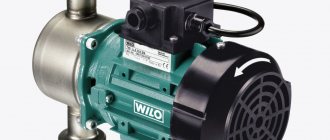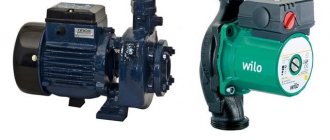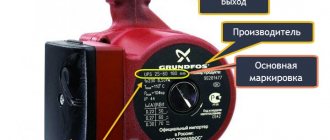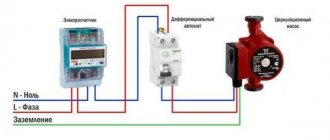Uniform distribution of the coolant inside the pipeline and radiators is ensured by using a pump for the heating boiler. The device maintains the required pressure in the system, helping the fluid overcome a difficult path. You can install the circulation pump yourself if you read the instructions and technical design of the device.
What is a circulation pump
One of the necessary elements in the hot water supply and heating system is the circulation pump. This device performs pumping and suction functions and promotes the active movement of liquid inside the heating system. The pump is mounted directly into the pipeline. Designed to operate in a closed loop.
The main elements of the device are:
- frame;
- impeller;
- rotor;
- motor shaft;
- terminal box;
- engine;
- air propeller.
As soon as electrical energy is supplied to the rotor, it begins to rotate, transmitting a signal to the impeller to move. This causes fluid to be sucked in from one side of the device and expelled from the other. To make the units easier to install and maintain, manufacturers produce different models in body shape and dimensions.
Prices for circulation pumps for heating boilers
circulation pumps for heating boilers
What is it used for?
Thanks to the circulation pump, the heating of the premises is carried out evenly and quickly, so the scope of application of such units is extensive.
Pumps are installed for the following purposes:
- Improving the quality of operation of a natural circulation system.
- Forced movement of coolant during geothermal heating. The heat pump operates according to the classic Carnot cycle: it takes in cold coolant deep below and in return receives a fluid flow heated to 50 degrees inside the heating system. In the summer, geothermal equipment transforms from a heater into a passive air conditioning device.
- Ensuring water circulation in hot and cold water supply systems in a private home.
- Increasing the efficiency of a warm water floor design.
- Use in air conditioning systems for cooling purposes.
Types of pumps
All electric pumps have a common operating principle, but differ in design and efficiency. To choose the right device, you need to know what types of equipment exist and how they differ.
There are two types of circulation units:
- With wet rotor. Such devices have a modular design, which simplifies their maintenance and repair. The rotor and impeller are in the working environment, only the electrical part remains dry. The devices have a low noise level. A step speed controller allows you to control the consumption of electrical energy. The advantage of the unit is its long service life if installed correctly. The disadvantage of the device is its sensitivity to the quality of the working fluid.
- With dry rotor. The pump differs in the type of design. The rotor is enclosed in a sealed housing, and the impeller is immersed in the coolant. The engine is protected from liquid penetration by sealing rings. The main advantage of the unit is its high efficiency and minimum requirements for the quality of the coolant. The device produces a high noise level.
Judging by the characteristics, we can conclude that devices with a wet rotor are more suitable for private houses and apartments.
Advantages of boilers with a pump
An electric boiler with a circulation pump, thanks to its unique design, can perform the functions of a whole complex of heating devices.
The increased demand for such equipment is due to its advantages:
- A large range of models makes it possible to choose a boiler for heating rooms of any size. The user does not need to select a pump separately.
- The device allows you to drive liquid through all circuits at optimal speed. This helps to heat the room evenly and quickly.
- The efficiency is 90% and above, which indicates the high efficiency of the models.
- Automation of the process ensures simple setup and high safety of boilers.
- The equipment is environmentally friendly, since no harmful substances are emitted during its operation.
- Simple installation of the heating system.
Manufacturers produce wall-mounted boilers that are suitable for small apartments, as well as floor-standing boilers that can provide heat to a large area.
Flaws
Boilers with built-in circulation pumps are not without drawbacks, familiarity with which will allow you to decide whether it is worth installing such equipment.
Main disadvantages:
- Electricity is more expensive than gas or solid fuel.
- The uninterrupted operation of the boiler directly depends on the voltage in the supply network.
- The need to install high-quality wiring in a heated room.
The disadvantages of using boilers are mainly related to the need to provide them with electrical energy. Before installation, it is necessary to calculate the current strength in order to select a cable of the required cross-section and a machine. To reduce the power of the boiler itself, a battery tank is installed on the output circuit of the heating system.
Models on the market
To avoid making mistakes when purchasing garden watering equipment, study all the technical specifications, compare different models , and also read the pros and cons.
Head up to 13 m
These are pumps with minimum power. Suitable for watering from a container or for supplying from water from a shallow depth.
Karcher BP 1 Barrel Set
A simple model for a barrel or other container. The cost in online stores is 7,600 rubles.
Specifications:
- suction depth – 7 m;
- maximum possible pressure – 11 m;
- power – 400 W;
- float switch.
This pump is perfect for a small area. Its main advantage is high-quality assembly and low noise. The manufacturer provides a guarantee for the device - up to 730 days of operation without breakdowns. Read reviews here.
LEO XHm/5C
Surface pump. High performance. The average price is from 11,000 rubles.
Specifications:
- maximum pressure – 12.5 meters;
- the ability to pump contaminated water - alkaline and acidic liquids (in low concentrations);
- power – 600 W;
- maximum water temperature +60 degrees.
The device has a built-in thermal protection relay, operates almost silently and is ideal for installing an irrigation system in a summer cottage. Despite its high power, the device has compact dimensions and is suitable even for a small area.
Head from 15 to 35 m
These are medium pressure range pumps. Suitable for deeper wells . They are almost never used for watering from containers.
Pedrollo CPm160C
This is an excellent and very reliable pump for watering garden beds. Cost in online stores – from 24,000 rubles.
Specifications:
- water suction depth – 7 m;
- maximum possible pressure – 32 m;
- power – 1100 W;
- suitable for pumping hot water;
- Works well in hot outdoor conditions.
The pump is easy to install and operates for many years without breakdowns. Suitable for non-aggressive liquids without heavy contamination.
Metabo P 2000G
Very compact device for self-installation. The main advantage is the asynchronous motor. Cost – about 4500 rubles.
Specifications:
- maximum possible water pressure – up to 30 m;
- suction depth – 8 m;
- total power – 450 W;
- Suitable for working with hot water in hot weather.
The pump does an excellent job of pumping groundwater, as well as any other clean water. If the operating rules are followed, the device will operate for several years without breakdowns or repairs. Read reviews here.
Head from 35 m
Universal devices , suitable for ponds, plumbing, and containers.
AL-KO Jet Inox Classic
The device is suitable for working with both clean and chlorinated water. The cost in hardware and garden equipment stores is about 6,000 rubles.
Specifications:
- possible pressure – 35 m;
- economical energy consumption;
- high efficiency.
The device works properly in any conditions and does not create an increased load on the network. Can be used to supply water both from a well and from a tank - in all cases, the pressure will be optimal for the normal operation of the drip irrigation system. Read reviews here.
Hammer NAC 1000A
Powerful and convenient submersible pump. To install a drip irrigation system, it is important to correctly install the device on the ground and connect all hoses for supplying and discharging water.
Specifications:
- suction depth – 8 m;
- Suitable for clean water only;
- protection of the device from overheating during operation;
- power – 36 m.
The pump is installed in a horizontal position. Works smoothly and has high performance. Read reviews here.
Types of devices for boilers
Pumps embedded in the heating circuit increase the circulation of coolant in the pipes. Depending on the area of application, they differ in design and technical parameters.
The devices are divided into two types: circulation pumps for a gas boiler and feeders for steam units. The main thing is to choose the right device for a specific pipeline and boiler characteristics.
Circulating
Many models of single- and double-circuit gas boilers are equipped with circulation pumps that are installed next to the hydraulic unit. For domestic needs, the ideal option is single-phase pumps with a power of up to 100 W, providing a liquid pumping speed of up to 2 m/s. These models are easily installed on plastic pipes and can last for a long time without repair, as they are assembled from stainless components.
Pumps in single-circuit gas boilers, as well as in electric ones, are “wet” and “dry”. They are necessary in cases where there is low gas pressure in the system. The unit helps such a boiler develop power up to 80%.
Nutritious
Industrial installations designed to supply coolant to steam boilers of power plants or oil refineries are called feed pumps. The units, depending on the type of model, pump water with temperatures from 80 °C to 165 °C. The amount of impurities in the liquid should not exceed 0.2%.
Feeding units are produced in several types and in various designs. They are used in difficult conditions, so many are equipped with an automatic shut-off device. Each unit has a check valve - this is a protective measure to prevent reverse rotation of the rotor or overheating of the water.
The working part of the devices is made of steel, cast iron alloys or non-ferrous metals.
The best premium pumps for home heating systems
Models in this category are distinguished by high performance and power. They are used in multi-storey residential buildings or enterprises.
Such pumps are very expensive, but they have flexible settings, ease of control and are extremely reliable.
ESPA RE1-F SAN SUP 40-80-B 230 50
5.0
★★★★★
editorial assessment
100%
buyers recommend this product
The device has a lightweight design and is easy to install. It is equipped with an LED display and a three-stage electronic power regulator, which makes it easy to control operating modes and all key parameters.
The automatic setting function sets the most suitable pressure according to your current needs. Thanks to the use of a permanent magnet motor, energy savings of up to 70% are achieved.
Advantages:
- flexible setup;
- information screen;
- saving electricity;
- quiet operation;
- remote control.
Flaws:
- high price.
ESPA RE1-F SAN SUP 40-80-B 230 50 has a capacity of up to 35 cubic meters per hour. Such a pump can be installed in industrial buildings or large residential buildings with a multi-stage heating system.
AQUARIO AC 14-14-50F
4.9
★★★★★
editorial assessment
94%
buyers recommend this product
A special feature of the model is the high pressure indicator. A durable cast iron body, technopolymer impeller, natural lubrication and cooling of components help extend the service life of the device.
The maximum pump performance is 466 liters per minute, pressure 10 atmospheres. The device is silent during operation and easy to install due to its compact size and simple threaded connection.
Advantages:
- long service life;
- high performance;
- small dimensions;
- silent operation.
Flaws:
- lack of speed controller.
Aquario AC 14-14-50F will be an excellent purchase for installation in a multi-storey building. A pressure of up to 16 meters guarantees stable operation of the pump in a branched system.
How to choose a pump
To choose the right circulation unit, you need to know its functionality. You can familiarize yourself with them in the technical documentation provided by the manufacturer along with the pump. It is worth paying attention to the material from which the body of the circular device is made and the presence of protection.
Main parameters:
- Performance. This value is the maximum volume of coolant that the device can pump in one hour. Unit of measurement is m³/h.
- Pressure The indicator is measured in meters and represents the maximum value of hydraulic resistance.
- Speed. Allows you to adjust heat transfer depending on the outside temperature. It is better to choose devices that can operate at different speeds.
- Power. The smaller the diameter of the heating system pipes, the more powerful the engine should be.
- Temperature. How many degrees will the liquid in the heating system heat up to?
Pump selection criteria
When planning to purchase pumping equipment and pipes for installing a drip irrigation system, you must first determine where the water will come from.
If you are going to pump out settled or rain liquid from tanks, barrels or cisterns, you should pay attention to models for working with artificial containers. This can be a compact submersible unit with a suction depth of up to 5 m. It is simple and quick to install, copes well with water supply, and does not consume too much electricity.
We have provided more recommendations on choosing a pump for irrigation from a barrel and a pond in this material.
When there is a swimming pool on site, a submersible pump can be used to refresh the fluid in the tank. If you plan to water the beds with water from the pool, it is better to avoid chemical cleaning products. Otherwise, the remains of aggressive substances will get into the food.
In order for equipment to function properly, breaks are required during operation. Otherwise, the device will quickly fail.
A surface pump is useful for raising water from large open sources, wells and shallow wells. Such models suck water from a depth of 7-8 m and demonstrate high efficiency. They differ from each other in power, pressure and performance. For small areas located close to the source of water intake, economical devices with a pressure of up to 25 m are suitable.
If the place that needs watering has a large area and is located far from the water intake point, it is better to buy the most powerful module with a pressure of 35-55 m. It will make it possible to quickly provide water to a large area with beds and flower beds.
It is recommended to place surface models on a flat surface and protect them from atmospheric influences. It is advisable to locate them far from residential buildings so that the noise level does not interfere with the owners’ relaxation and going about their business.
Drainage pumps should be preferred by those who do not have access to clean water and are forced to pump liquid from nearby rivers, ponds or other natural bodies of water. The drainage model will clear the water flow of large particles of impurities and will not allow them to damage the internal elements of the communication system.
Where to install
There are different opinions among experts regarding the installation of the unit in the system. Some suggest installing the pump on the supply pipeline, others on the return line.
In a home system, the temperature rarely rises above 70 °C, and the liquid does not heat up more than 90 °C. Therefore, the unit can be embedded in both the supply and return pipelines, while the difference in statistical fluid pressures between them is not significant, but it is better to focus on the second option. If there are two separate branches in the heating system, then it makes sense to install a separate device on each.
The pump must be installed immediately after the boiler, before the first branch in the circuit. Then it will be possible to set the required thermal conditions in each part of the house.
Forced circulation
In houses with a large area, air pockets may form in the system, which leads to disruption of circulation, overheating of the coolant in the boiler and damage. Therefore, a pump is installed in the return pipe before entering the boiler heat exchanger, which carries out forced circulation. This allows you to maintain the desired fluid speed and pressure.
The coolant often contains mechanical impurities that can damage the engine or cause the impeller to jam, so a dirt filter is installed in front of the device. Ball valves installed on both sides of the device allow you to repair or replace the unit without draining the liquid from the system.
Natural circulation
The process got its name based on the laws of physics. Thanks to the strictly maintained slope of the supply and return pipes, the heated liquid rises to the top point of the system, then, as it cools, it falls down, returning to the boiler. When operating in this mode, heat transfer will be low, in addition, a power outage is possible, so a pump is installed into the system. This gives high heating efficiency and reliability.
Additionally, a bypass line for the pump is installed - a jumper, which makes the system operational when the boiler is turned off. A ball shut-off valve is installed in the jumper. It opens when the power goes out or the appliance fails. The tap leading to the pump is closed, and the system begins to operate on the principle of gravity.
Where circulation units should not be installed
It is not advisable to install circulation pumps on the supply line. There are cases when air accumulates in the upper part of the boiler, the device cannot draw it in, as a result, a vacuum is formed, which leads to boiling of the coolant.
The resulting steam-water mixture begins to move into the system. The pump stops because it can only pump water. If measures are not taken in time, an explosion is possible.
General structure of a water pump
The water pump is built into the heating circuit to ensure the movement of the coolant. Therefore, such systems are called forced circulation heating.
It consists of the following basic elements:
- housing with a working chamber;
- engine;
- impeller;
- air bleed screw;
- terminal box.
The terminal box can be equipped with additional mechanical and electronic equipment designed to regulate the operating mode of the motor.
The simplicity of the device ensures high reliability of the pumps, thanks to which they can operate effectively for about 5-10 years.
During the first start-up of the water circulation pump, you need to unscrew the air screw and bleed air from the working area
Installation rules and nuances
It is advisable to entrust the installation of the pump to a specialist. In the technical documentation, the manufacturer indicates installation rules, so you can try to do the work yourself. The main thing is to adhere to the rules for handling the device.
To avoid the formation of air pockets, which can lead to equipment breakdown, it is important to choose the correct location of the rotor relative to the horizon. There is a hint on the body of the device in the form of an arrow indicating in which direction the liquid in the system should move. The site must be selected in a place convenient for operating the unit.
Installation diagram
There are several schemes for connecting the pump to the boiler. The desired option is selected based on the type of system and type of heating equipment. In all schemes, the device is mounted so that it is comfortable to service.
Possible methods:
- The unit is installed on the return line directly in front of the heat generator.
- The pump is installed at the beginning of the circuit after the safety group.
- The device with shut-off valves is placed on the bypass.
- Used when connecting the pump to a solid fuel boiler. It is better to fix the device on the line that goes from the heating system to the heat generator.
Installation of a circulation device on the return line.
How to connect to power supply
The device operates from a 220 V network. Connection requires three wires: phase, neutral and ground.
It can be connected to power in two ways:
- Directly by cable or via terminal block. It is necessary to draw a separate electrical line with a circuit breaker, and use this cable to connect the device. The terminals are usually located under a plastic cover. You need to remove it by unscrewing several bolts and finding three connectors. They are signed: pictograms N - neutral wire, L - phase, and “ground” has an international designation.
- Through a three-pin socket and plug. New wiring needs to be done. Install an external or internal outlet. To connect the unit to the network, you will need a power cable with a grounding plug.
When to install additional equipment
The functioning of the entire heating system depends on the performance of the pump. To prevent sudden shutdown of the unit, it is worth additionally providing backup power. To do this, you can install a stabilizer with connected batteries. The main thing is to correctly select and calculate the capacity of the devices and ensure that they do not discharge.
You can reduce energy costs and increase the service life of the device by installing a thermostat that measures the temperature of the liquid. The pump will start if the indicator reaches the required level.
The best wet-running pumps for home heating systems
Models of this type have insulation only of the stator and other elements of the electric motor, while the rotor and impeller are in contact with the coolant.
Wet-running pumps are reliable, low-noise and do not require frequent maintenance, but have a low efficiency of about 50% and low power.
GRUNDFOS UPS 32-80 180
5.0
★★★★★
editorial assessment
100%
buyers recommend this product
See review▶
The main features of the model include flexible operation settings and economical energy consumption. It is ensured by selecting the speed mode of shaft rotation using a switch on the terminal box.
The device also has the ability to operate on a timer and with automatic performance control. The maximum pressure is 10 atmospheres, the liquid temperature is allowed within the range from -25 to +110 °C.
Advantages:
- easy connection;
- long service life;
- speed setting;
- silent operation.
Flaws:
- high price.
Grundfos UPS 32-80 180 produces a pressure of up to 8 meters and is designed for installation in one-story houses. An excellent choice for both closed and open-loop heating systems.
WILO Star-RS 25/2
5.0
★★★★★
editorial assessment
97%
buyers recommend this product
The reliability of the model is ensured thanks to a blocking current-resistant electric motor, a perforated stainless steel shaft design and a water filtration system.
Maximum pressure is 2 meters, productivity is 2.2 m³/h. Support for horizontal shaft positioning and double-sided connection of the terminal box make it easy to install the pump in various places in the pipeline.
Advantages:
- durability;
- ease of installation;
- low price;
- economical energy consumption.
Flaws:
- lack of fastenings in the package.
Wilo Star-RS 25/2 is suitable for home use. Quiet operation and a five-year warranty make the pump comfortable and reliable.
GILEX "Compass" 25/80
4.8
★★★★★
editorial assessment
88%
buyers recommend this product
Thanks to a convenient valve located on the body of the model, the user has the opportunity to quickly release air that accidentally gets into the heating system. This ensures uniform heating in all areas.
A three-mode shaft rotation speed switch ensures economical energy consumption and comfort during use. The noise level during pump operation is 45 dB, the maximum pressure is 8 meters.
Advantages:
- protection of fastenings from corrosion;
- speed shifter;
- air valve;
- low noise level;
- overheat protection.
Flaws:
- requires regular flushing of the system.
"Compass" 25/80 can be used in multi-stage heating systems. The right solution for installation in large buildings or low-rise buildings.
Step-by-step instructions for assembling and installing the pump
After purchasing the device and choosing the location for its installation, it is necessary to carry out assembly and installation. It is first necessary to install ball valves on both sides of the pump, and install a mud trap in front of the unit to retain scale, dirt, and abrasive particles. The upper part of the bypass must be equipped with an air valve.
Assembling and connecting the pump to the heating boiler is carried out in the following sequence:
- Before installation, drain the liquid from the system. For complete cleaning, you need to fill it with coolant and drain it, then repeat this procedure a couple more times.
- Install the pump into the system.
- After installation, all connections must be carefully sealed.
- Fill the system with liquid. Remove excess air.
- Connect the device to the electrical network.
The number of circulation devices required in the system depends on the length of the pipeline.
Advantages of circulation devices
Until 1990, heating systems in private buildings were designed and built primarily without pumps. The coolant moved through the pipes by gravity, and its circulation was ensured by convection flows of liquid when it was heated in the boiler. Currently, natural circulation systems are still used, although not as often.
Inexpensive solid fuel boilers are produced without built-in pumps, because the manufacturer does not know the parameters of the heating circuit. For such systems, the purchase of a water pump is mandatory.
Nowadays, coolant movement is carried out forcibly using water pumps, which have a number of advantages:
- Reduced load on the boiler by reducing the temperature difference in the incoming and outgoing pipes.
- Uniform distribution of heat throughout the rooms due to the same temperature of the coolant along the entire length of the heating rings.
- The ability to quickly regulate the temperature of the coolant.
- Quick heating of the heating system when starting a cold boiler.
- There is no need to install pipelines with a slope towards the boiler, ensuring spontaneous movement of the coolant.
- Possibility of using thin pipes that take up little internal space in the apartment.
- The power of the pump allows you to build up pressure in the heating circuit sufficient to supply coolant several floors up.
- Use of shut-off valves on individual loops of heating networks.
- Possibility of integrating the pump into the automatic control system of the boiler.
With a lot of advantages, circulation devices also have two disadvantages - dependence on power supply and additional costs for electricity.
But the disadvantages are easily compensated for - installing a water pump allows you to save 10-20% of fuel, and the share of the cost of electricity in total heating costs is only 3-5%. In addition, if there is a frequent lack of electricity, you can install a UPS, which will ensure autonomous operation of the boiler and pump for a certain period.
Cost of different types of pumps
There are many companies on the market specializing in the production of circulation units. Consumers are advised to buy models from reputable European manufacturers. The products of some Russian enterprises are also in demand.
| Model | Manufacturer country | price, rub. |
| Prima UPS 25/60 180 | Russia | 1570 |
| Wester WCP 25-40G | Russia | 2127 |
| LRP 32-50/180 | China | 2598 |
| Hoffmann UPC 25-40 180 | Germany | 5256 |
| Yonos PICO 15/1-4 | Germany | 6051 |
| A 56/180 XM | Italy | 10953 |
You can find both budget and expensive models on sale. Which pump to buy for a heating boiler is an individual decision for the home owner. When choosing, some are guided by the level of popularity of the manufacturer, others - by cost, and still others - by the availability of the service. Learn how to choose a heating radiator by following the link.
Where and at what price are they sold?
Devices of various types, with a pressure power of 13 or over 35 m, are sold in various stores specializing in the supply of technical equipment:
- 220 volt;
- Bison;
- Karcher;
- Makita;
- Vortex;
- Teplotek South;
- Tiu.ru;
- Ozone, Wildberries.
Prices in most stores correspond to the standard - low-power models can be purchased from 2000 rubles. Powerful devices cost 4,000 – 10,000 rubles. You can also purchase a ready-made irrigation system at a price of 5,000 rubles.
Types of pumps and their features
Various circulation units can be installed in the heating system of a private house. They are divided into two large groups. The circulation pump can be “dry” or “wet”. When installing devices of the first type with your own hands, you should take into account that their motor is separated from the working part by sealing rings. They are made from stainless steel. During the startup of the installation, the process of movement of these rings begins, which leads to sealing of the connection with a water (very thin) film. The latter is located between the seals.
Circulation pump unit
High-quality sealing in this case is ensured due to the fact that the pressure in the external atmosphere and in the heating system itself is characterized by different indicators. A “dry” pump makes quite loud sounds when operating. In this regard, its installation is always carried out in a specially soundproofed separate room of a private house. The efficiency of such a circulation unit is at the level of 80%.
There are three types of “dry” devices for connecting to the heating system: horizontal, vertical, block. The electric motor in units of the first type is placed horizontally. The discharge pipe is attached to them on the body of the device, and the suction pipe is attached to the shaft (on its front side). In vertical installations, the pipes are on the same axis. And the engine in this case is located vertically. In block circulation units, heated water exits radially and enters the system in the axial direction.
Caring for a “dry” unit is objectively difficult. Its elements must be regularly lubricated with a special compound. If this is not done, the mechanical seals will quickly fail, causing the pump to stop. In addition, in a private home, “dry” devices should be placed in rooms where there is no dust. Its turbulence during equipment operation often causes depressurization of the pump.
In “wet” units, the lubricant function is performed by the coolant itself. The impeller and rotor of such installations are immersed in water. “Wet” devices are much less noisy and easier to install with your own hands. And their maintenance is simpler compared to “dry” pumps.
The body of a “wet” installation is usually made of brass or bronze. Between the stator and the rotor there is always a special stainless steel separator. It's called a glass. It is necessary to provide the required tightness to the engine (more precisely, its elements under electrical voltage). It is “wet” units that are most often installed in a heating system in a private home.
They do a good job of heating relatively small areas. Such devices are not suitable for large objects, since their productivity usually does not exceed 50%. The low efficiency of “wet” installations is due to the impossibility of high-quality sealing of the cup placed between the stator and the rotor.
Which company should you choose?
Another important criterion for choosing a circulation pump is its manufacturer . It is better to give preference to models produced by specialized manufacturing companies.
They pay increased attention to the materials and reliability of their devices, provide a guarantee on pumps, and the devices themselves are completely safe and easy to use.
The best circulation pumps are produced by Grundfos, Wilo, Aquario, Wester and VORTEX.
Devices from these exact brands are included in the selection.
How to choose equipment?
Before purchasing equipment, it is necessary to take into account a set of technical characteristics of circulation pumps. These include:
- Performance. To do this, it is necessary to make an accurate calculation, which ensures uniform heating of the living space.
- Calculation of head height. For example, if the pipeline length is more than 15 m, then the pressure pressure will be up to 0.6 mm.
- Regulation of fluid supply speed.
- Installation power. The higher the electrical power of the equipment, the higher the price of the circulation pump
About the choice of equipment and the rules for its independent calculation
The key indicator that determines the efficiency of the circulation pump is its power. For a household heating system, there is no need to try to purchase the highest-power installation. It will only make a loud noise and waste electricity.
Mounted circulation pump
You need to correctly calculate the power of the unit based on the following data:
- hot water pressure indicator;
- pipe section;
- productivity and throughput of the heating boiler;
- coolant temperature.
Hot water consumption is determined simply. It is equal to the power indicator of the heating unit. If, for example, you have a 20 kW gas boiler, no more than 20 liters of water will be consumed per hour. The pressure of the circulation unit for the heating system for every 10 m of pipes is about 50 cm. The longer the pipeline, the more powerful the pump you need to purchase. Here you should immediately pay attention to the thickness of the pipe products. The resistance to water movement in the system will be stronger if you install pipes with a small cross-section.
In pipelines with a diameter of half an inch, the coolant flow rate is 5.7 liters per minute at the generally accepted (1.5 m/s) speed of water movement, with a diameter of 1 inch - 30 liters. But for pipes with a cross-section of 2 inches, the flow rate will already be at the level of 170 liters. Always select the diameter of the pipes in such a way that you do not have to overpay extra money for energy resources.
The flow rate of the pump itself is determined by the following ratio: N/t2-t1. In this formula, t1 refers to the temperature of the water in the return pipes (usually it is 65–70 °C), and t2 is the temperature provided by the heating unit (at least 90 °C). And the letter N denotes the boiler power (this value is in the equipment passport). The pump pressure is set according to the standards accepted in our country and Europe. It is believed that 1 kW of power of a circulation unit is quite enough for high-quality heating of 1 square meter of a private home.
